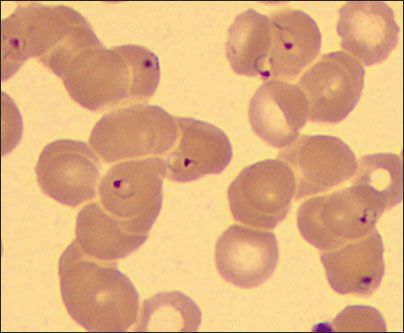Malaria
During a flight from Houston to New York, a 46-year-old man had fever, chills, rigors, and body aches. After he landed, he sought treatment at a local hospital. The patient was on his way back to Liberia, where he works. He had been at home in Houston for several weeks. In the emergency department, he complained only of subjective fever.

During a flight from Houston to New York, a 46-year-old man had fever, chills, rigors, and body aches. After he landed, he sought treatment at a local hospital. The patient was on his way back to Liberia, where he works. He had been at home in Houston for several weeks.
In the emergency department, he complained only of subjective fever. Vital signs and physical findings were normal. The platelet count was 51,000/μL, the total bilirubin level was elevated at 2.5 mg/dL, and the initial hemoglobin level was 12.6 g/dL.
Further questioning revealed that the patient had had a bout of malaria with similar symptoms a year and a half earlier. He had been given prophylactic medication before his trip but had not taken it as directed.
The patient was hospitalized. An initial blood smear (shown) identified Plasmodium falciparum with 13% infectivity. Mefloquine, 1250 mg in divided doses of 750 mg and 500 mg 6 hours apart, was started. Over the next several hours, mild jaundice developed as well as a mild petechial rash on the lower extremities. The total bilirubin level had increased to 8.3 mg/dL (direct bilirubin, 6.4 mg/dL). The platelet count was 61,000/μL.
Overnight, the patient had another episode of fever and rigors. When he was examined the next day, his mental status was intact, but the petechial rash and jaundice had worsened; his eyes were icteric. The hemoglobin level was 8.0 g/dL, and total bilirubin level increased to 9.4 mg/dL (direct bilirubin, 5.3 mg/dL).
The CDC was contacted. The patient was found to meet the criteria to receive intravenous artesunate. The hospital’s institutional review board approved the research protocol and supplied written consent. The patient received the first dose on hospital day 2 and additional doses 12, 24, and 48 hours later. Between days 2 and 3, the patient also underwent an exchange transfusion to help clear the infection and prevent cerebral malaria and its complications. After the second artesunate dose, a repeated blood smear showed no parasites.
The patient had no adverse effects from artesunate. He was monitored for 24 hours after the last dose and then discharged home on a regimen of doxycyline. He was encouraged to take prophylactic medication before traveling to and while in Africa.
The choice of malarial treatment depends on various factors, including the malaria strain, region of travel, and comorbidities.1 In the United States, artesunate is classified as an investigational new drug. The criteria for administration of this drug include severe malarial disease; the inability to take oral medication; and quinidine intolerance, contraindication, or failure.2
A key benefit of artesunate is that it targets all erythrocytic stages of P falciparum,3 unlike other antimalarials that target only specific stages and species.1 In addition, artesunate has a rapid onset of action.3 Because of this, a second, longer-acting agent, such as mefloquine, is usually administered simultaneously to prevent a late recurrence.3
It is strongly recommended that all patients who travel to malaria-infested regions take prophylactic medication. 4 Emphasize the importance of taking the medication as directed to prevent serious disease.
References:
Acknowledgment:
We thank Farshad Bagheri, MD, Jose Cervantes, MD, Mohammed Barbury, and Laurie Horowitz, MD, of Jamaica Hospital Medical Center and Paul Arguin, MD, of the CDC for their assistance in patient care.
REFERENCES:
1.
Baird JK. Effectiveness of antimalarial drugs.
N Engl J Med.
2005;352:1565-1577.
2.
Artesunate now available to treat severe malaria in US. Atlanta: Centers forDisease Control and Prevention, Division of Parasitic Diseases; July 30, 2007.
http://www.cdc.gov/malaria/features/artesunate_now_available.htm
. AccessedApril 21, 2009.
3.
Rosenthal PJ. Artesunate for the treatment of severe falciparum malaria.
N Engl J Med.
2008;358:1829-1836.
4.
Freedman DO. Clinical practice. Malaria prevention in short-term travelers.
N Engl J Med.
2008;359:603-612.